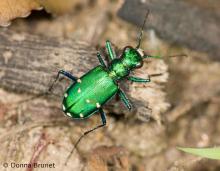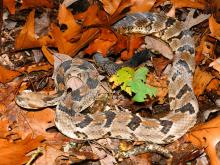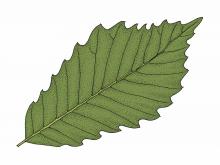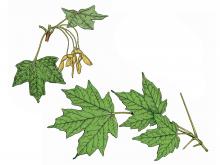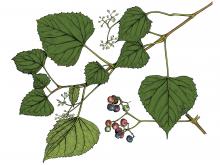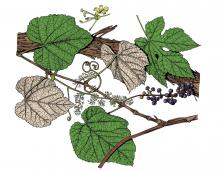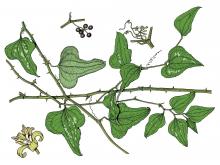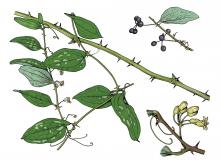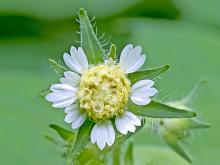
We most often hear about talus (pronounced TAY-luss) when people talk about alpine habitats and glaciers, but talus occurs in Missouri, too. It’s a naturally occurring slope made of a jumble of loose rocks that have fallen from a rocky cliff or other rock face above.
A talus natural community, by definition, must have more than 50 percent of its area covered by coarse rocky debris. The slopes range from 15 to 60 percent.
In general, talus habitats are rocky places with little soil and rather sparse vegetation.
Rock type has a strong influence on the character of talus communities, as different types of rocks respond differently to the processes of freezing and thawing, differ in how quickly they break down and form soils, and vary in their effects on soil pH.
In talus slopes, the mass of rock actively moves downward with gravity and with the arrival of newly broken-off rocks from above. This downward shifting topples and damages trees.
Talus Plants
Vegetation can be patchy or barren on talus, or it can be dense and covered with trees. The amounts and types of vegetation depend on how much organic matter accumulates amid the pile of rocks. Over time, branches and leaf litter falls or slumps from nearby cliffs or slopes. As these materials decompose, soils develop, supporting plant growth.
In sun-exposed areas, talus communities tend to be hot and dry, but in sheltered, north-facing areas, they can be cool and damp.
In dry talus communities, the most prominent plant types are vines and lichens. In moist, shaded talus communities, mosses, ferns, algae, fungi, and cyanobacteria (blue-green algae) are prominent. Trees typically struggle to survive in talus, often sustaining root damage or falling over, as the unstable rocks shift around. Trees in talus often have missing limbs or bear scars caused by falling rocks. These injured trees are more likely to succumb to root fungus and to be blown over by strong winds.
As soils build up in a talus community and vegetation increases, trees may become established that can eventually stabilize the rock mass, allowing the development of deeper soils and increased vegetation. Eventually, the talus community can be transformed into another type of natural community — a mesic limestone/dolomite forest, for example.
Talus Animals
Although talus is an unstable, generally inhospitable place for large animals, it offers an excellent habitat for small, agile animals. Many talus communities occur along rivers and streams, allowing animals to take shelter in the cool, moist pockets created by the jumble of boulders.
- Amphibians. Cave salamander, southern redback salamander, and pickerel frog. In north-facing, cool, moist talus, Ozark zigzag salamander and four-toed salamander are notable.
- Reptiles. These especially use the talus for overwintering sites: timber rattlesnake, cottonmouth, and northern watersnake.
- Birds and small mammals (such as rodents). Species living in nearby woodlands or forests often visit talus communities.
- Invertebrates. Spiders, beetles, snails, and slugs are commonly present.
Types of Talus Communities
In Missouri, two types of talus communities have been identified.
Limestone/dolomite talus
Limestone/dolomite talus is created by fragments of rock that have broken off cliff faces. Shrubs, wildflowers, vines, mosses, liverworts, and lichens cover up to 40 percent of the area. Trees are absent or rare. Soils are slightly acidic to moderately alkaline. This community occurs statewide along large streams and rivers, especially in the Ozarks and along the Mississippi River in northeast Missouri.
Representative Limestone and Dolomite Talus Sites
- Ha Ha Tonka Oak Woodland Natural Area
- Big Spring Natural Area
- Grand Bluffs Natural Area
- Vilander Bluff Natural Area
- Jam Up Bluff and Angel Bluff in Jacks Fork Natural Area
- Cardareva Bluff Natural Area
Igneous talus
Igneous talus is created by long-term weathering and erosion of cliff faces or mountain domes, which causes large rock fragments and boulders to accumulate below. Shrubs, annual wildflowers, vines, mosses, liverworts, and lichens are sparse. Trees are sparse to absent. Soils are very strongly acidic to moderately acidic. This community occurs in the St. Francois knobs and basin and Current River hills region of southeastern Missouri.
Representative Igneous Talus Sites
- Mudlick Mountain Natural Area
- Johnson’s Shut-Ins Natural Area
- Bell Mountain Wilderness (Iron County)
- St. Francois Mountains Natural Area
Statewide, but talus communities are best developed in the southern half of the state and along major stream drainages, including along the Mississippi River.
Key species

